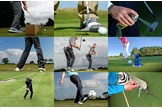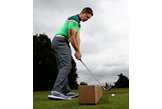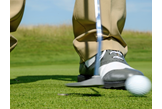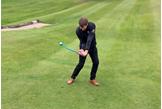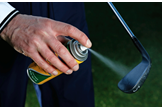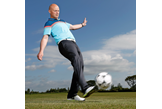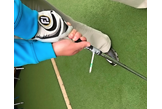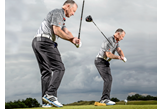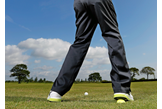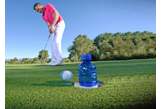33 of the best free swing aids
Published: Last updated:
Who needs expensive practice gadgets when you’ve already got 33 of them around the house…
It won’t have escaped your notice that there is an entire industry of swing aids out there, each one promising you a straighter this and a longer that. But we’re also sure you’ve noted the often absonant prices that accompany them.
And while many of them may well do the job for which they’ve been created, it does rather beg the question of whether the same effect can be achieved without having to part with an arm or indeed a leg. This was the very question we put to our Top 50 coaches.
Happily they’ve obliged with a series of great drills, each one using a prop you either already possess or can buy very cheaply… from bath tubs to dog ball throwers. Together, they deliver a fun and easy way of bringing that handicap down – while keeping your cash in your pocket.
Prop #1: Dog ball thrower
Purpose: Train a later and more powerful release of the club
No doubt you’ve either seen or used one of these, basically a bendy piece of plastic that holds then launches a ball for your mutt. But it can make a great practice aid. Grip it like a golf club, the ball facing forward, and swing. If you cast the club or release too early, the
ball releases out of the clasp and
hits the ground before the
impact zone. Hold on to your
wrist angles approaching
impact and the ball releases
later, hitting the ground after
the point of impact. Simon Payne, Cowglen GC

Prop #2: A £1 coin
Purpose: Improve the rhythm of your putting stroke
Most putter designs let you place a coin on them – either on the angle behind the face of a blade, or on the top of a mallet. So take a pound coin and place it on the putter. Hit some mid-range putts, from 15-25ft. With a smooth rhythm, the coin will stay in place; if the stroke gets jerky, the coin will slip and fall. Aim to hit 10 putts in a row keeping the coin staying in place. Gareth Johnston, Calcot Park GC
Prop #3: A pair of glasses
Purpose: Stop hitting the ball too hard
In our constant search for more distance, it’s all too easy to try to hit the ball
too hard… and lose control. To
eliminate this, practise
hitting full shots wearing
an old pair of glasses or
sunglasses with the right
lens covered up (for right-
handers). With your vision
restricted like this, you will lose sight of the ball as soon as you try to hit too hard because your head will have turned along the line of the flight too soon. Keeping your left or lead eye on the ball until after impact will promote a slower, smoother swing and a much more con dent strike.
Alan White, Lanark GC
Prop #4: A tee peg
Purpose: Promote the correct ball-turf iron attack angle
Place a tee peg deep into the ground a couple of inches target side of the ball. Take your 7-iron and strike the ball. Miss the tee peg after the ball and your swing’s low point is before the ball, your angle of attack too shallow. You can’t compress the ball powerfully. Clip the tee peg out after you strike the ball and your angle of attack and low point will be pretty much spot on. This means a strong, centred strike and no more thinshots.
Gary Nicol, Archerfield GC
Prop #5: A tee peg and tape
Purpose: Keep the clubface neutral
Stick a tee peg through some adhesive tape (pictured below). Wrap the tape around the base of the grip of your 6-iron so the tee peg points directly forwards. Take your grip, and look down; the leading edge of the clubface, the tee peg and the middle of the grip should all be in line. Focusing on the tee peg, swing the club back. If you can keep the tee in the middle of the grip during your takeaway, you will allow the face to rotate naturally with the arc of the club. This will help you feel how to keep the clubface in a neutral position during the first part of the swing.
Hugh Marr, hughmarr.com

Prop #6: A bathtub
Purpose: Smooth out your putting stroke
More often than not, missed putts are caused by a quick and snatchy putting stroke. To help get the feeling of a slow, smooth action, ll your bath with 6-8in of water. Stand at the side of the bath and take your putting stance. Grip a few inches down the handle and put the head of the putter in the water. Now make practice strokes, just as you would before you hit a putt. The water’s resistance will slow your stroke down to the speed it should be at all the time. Do this as often as you can to groove a stroke with rhythm.
Alan White, Lanark GC
Prop #7: A stepladder
Purpose: Smarter greenside shot selection
This is as much a concept as a prop in itself, but the image of a stepladder can help you choose the most effective club to chip with around the green. Picture a step ladder in front of you. You can chip the ball over whichever step you choose, but note this one simple rule: the higher you climb up the ladder, the bigger the risk for the shot. When selecting your club around the green, aim to hit over the lowest rung that allows you to pitch the ball on the green. That will always be your most reliable – and lowest-risk – option.
Gary Casey, Thorpe Wood GC
Prop #8: Your mobile
Purpose: Keep your head still when putting When your head moves during your putting stroke, you cause yourself a range of problems involving the blade’s aim and the stroke’s tempo. Both compromise distance and direction control. But here’s how to put an end to it. Take your putting posture. Ask a friend to put your – or ideally their – phone on your head. Suddenly, your incentive to keep your head still has shot up! Hit putts without the phone falling and you’re training a still head and a better strike. Jon Wallett, Elite Coaching Golf Academy
Prop #9: A football
Purpose: Train a strong, supporting trail arm position Find a football and balance it in the palm of your right or trail hand (right-handers). Now swing to the top. The only way the ball can stay balanced is through a good arm position, the elbow tucked and the palm remaining under the ball. When your trail arm finds this position, it allows the club to stay on plane while the clubface remains in a neutral position. Both of those will help you begin the downswing in good shape, meaning less need for pre-impact improvising. Dan Rees, Wexham Park GC
Prop #10: A coin
Purpose: Make a smoother start to your putting stroke
Place a pound coin immediately behind the ball. Address the ball normally, but let the putter’s head rest on top of the coin. You will instinctively rest the putter more lightly on the coin than you would on the ground. That helps take tension out of your hands and arms, helping you feel more relaxed in the arms and shoulders, which in turn encourages a smoother start to the putting stroke. The feeling of metal on metal also helps the putter glide away from the ball, promoting a fluid and rhythmical first move off the ball.
Scott Cranfield, Cranfield Golf Academy

Prop #11: A door stop
Purpose: More consistent putting stroke
You’ll deliver your best roll of the ball when you make a smooth, rhythmic stroke, controlled by your bigger arm and shoulder muscles. Put a doorstop between the butt and your lead arm to help.
Adrian Fryer, True Fit Golf Centre
Prop #12: 2-litre plastic bottle
Purpose: Keep your lead arm extended
Many golfers let their lead arm break down, either as they complete the backswing or through the ball. When this happens it affects the radius of the swing, causing striking inconsistency. To beat it, cut the top and bottom off a two-litre plastic bottle – be careful of the sharp edges – and slide the sleeve that remains over your elbow. Make a few swings with bottle in place. It keeps that lead arm extended, helping you feel how it needs to work during the swing.
Jon Woodroffe, World of Golf
Prop #13: A golf club box
Purpose: Train your swing path through impact Ask your pro for an old golf club box (or you may have one if you’ve bought any clubs over the internet). Throw a ball down in front of you. Position the box so its length runs inside the ball and parallel to the ball-target line – that’s just a hair left of the pin for right- handers. Play the ball opposite the middle of the box. Gareth Johnston, Calcot Park GC

Prop #14: A credit card
Purpose: Check putter aim
The putter’s aim at impact constitutes 83% of the ball’s starting line. That makes a square blade essential to the success of the putt. To help you check yours, set up to a short putt as normal. When you feel you’ve got the blade square, hold the putter’s position steady and squat down to replace the ball with the credit card. Position the card so its shorter edge sits flush against the putter’s blade. Now remove the putter and step back behind the ball-to-hole line to check where the credit card is pointing. Your blade aim will be revealed.
Simon Payne, Cowglen GC
Prop #15: A garden fence
Purpose: Stop whipping the club back inside the line
Swinging back on the inside is a major problem for many golfers and creates all sorts of issues with your downswing path. To work on it, choose a mid-iron and stand with your heels a foot away from your garden fence. Make backswings, ensuring you don’t hit the fence. If you are hitting the fence with your clubhead then your backswing is too inside. You need to make a backswing that misses the fence, but don’t cheat this by making an arti cial move that takes your hands away from your body. Instead, adjust your wrist movement to take the club on a steeper plane.
Kevin Hale, High Performance Coach
Prop #16: A football
Purpose: Create the right body angles for driver launch When your chest or sternum is behind the object you’re striking, you will inevitably hit it up. A simple way to feel how this works is to kick a football; you lean back to send it upwards. When you hit driver, x this image in your mind’s eye. As you swing down, aim to increase the feeling by leaning back through impact. Achieve this and you will send the ball up and out, with that yard-eating high launch.
Kevin Flynn, Tournerbury GC

Prop #17: A shoelace
Purpose: Train a straighter putting stroke
Simply tie the shoe lace to two pencils or long tees. Stick the tees or pencils into the green to stretch the lace out. Place a ball directly under the lace. Take your putting set-up; when the lace bisects the ball, your eyes are directly over the ball. Now remove the ball and swing the putter back and through. Check its path by watching how the head tracks in relation to the lace. When the two marry up, you’ve trained a pure swing path.
Gareth Benson, Formby Hall GC
Prop #18: A tube of toothpaste
Purpose: Increase power through appropriate grip pressure
Your hands can allow power
to ow from your body into
the club, or they can restrict it.
Grip too hard – an easy thing to
do when we are trying for power and
speed – and your movements become
tense, jerky and slow. So tonight, take the cap off your tube of toothpaste, hold it upside down and form your grip around it. Keep the pressure light enough to stop any toothpaste emerging. Register this pressure level, and set out to repeat it next time you play. Jon Wallett, Elite Coaching Golf Academy
Prop #19: Some Blu-Tack
Purpose: Hit the putter’s sweetspot for more control
Distance drops off with poor strikes, so the more centred your contact becomes the better your distance control will be. Put a small piece of Blu-Tack either side of where you want to strike the ball. Hit putts from 10 to 15 feet. You will straight away feel if you’re not finding the centre of the putter face because the ball will squidge against the Blu-Tack and the ball will finish a long way short of the hole.
Darren Paris, North Foreland GC
Prop #20: A frisbee
Purpose: Square the clubface for impact
The ideal delivery of the golf club sees the lead wrist at or even slightly bowed, with plenty of angle in the back of the trail wrist. To get the feeling of this lead wrist angle, nd a Frisbee. The natural action of throwing the disc places that lead wrist in the perfect position, the wrist bone extending forwards and the glove badge pointing slightly down.
Chris Ryan, The Belfry Academy
Prop #21: A sponge
Purpose: Build a more powerful downswing, on a better path We are often told to “push off from the back foot” to start the downswing, but this can lead to the heel pushing UP – a move that sees the trail knee move out, towards the ball, sending the club outside the ideal path. Instead, at the start of the downswing you need to feel pressure increase under the trail heel, so that it can work against the ground to drive you forward. So place a sponge under the heel.
As you start down, feel your foot squeeze the sponge. You’ll feel a stronger relationship with the ground, the foundation for a much more powerful downswing.
Adrian Fryer, TrueFit Golf Centre

Prop #22: A baseball/ rounders bat
Purpose: Find an effective backswing position
If you were to stand facing a baseball pitch, you’d demonstrate many of the key attributes of a golf backswing. You’d feel grounded, poised and ready to hit. Your right or trail arm and wrist would be powerfully folded, your left or lead knee holding position. You are poised and ready to drive momentum forward into the ball. This makes an effective hitting platform for golf, and keeps you in touch with the ideal impact position. So instead of turning away from the ball, the lead knee kicked in, picture this ‘ready’ baseball position to make a more powerful coil that helps you get back to the ball with more power and precision.
Richard Lambert, Crosland Heath GC
Prop #23: A slope
Purpose: Promote the correct ball-turf iron attack angle
A sideslope has the power to shape your swing. Ball-above-feet promotes a more rotary action on a flatter plane, while ball-below-feet encourages a more upright action. You can use this to your advantage; slicers, who need more rotation, should practise with ball above their feet while hookers, who need the club more in front of them, can practise with ball below.
Kevin Hale, High Performance Coach
Prop #24: Your shadow
Purpose: Kill a sway to promote stronger ball striking
Stand with the sun directly behind you. Position two balls so they’re just wider than the shadow of your hips. Take your regular set- up, ensuring your shadow falls between the two balls. Make your backswing. In a tight, efficient backswing your shadow will remain between them; if you sway, it will cover the back ball; any tendency to reverse pivot – falling forward – will shadow the front ball.
David Brooks, The Warren GC
Prop #25: A tennis ball
Purpose: Encourage a more rotary action… and thwart a slice
As a rule, slicers move the club too straight back and through the ball. Make your action more rotational and you’ll go a long way to fixing it. A tennis ball cut in half can help.
Kevin Flynn, Tournerbury GC

Prop #26: A pencil
Purpose: Stop your lead wrist breaking down
To putt consistently well you need your lead wrist to maintain a consistent angle through impact. This delivers the face squarely to the ball, without adding or removing loft. But many club players allow the wrist to break down through impact. To beat this, wear your watch on your lead wrist. Place a pencil through the strap, against the back of your wrist, so the sharp lead end points downwards. Hit some putts. If the wrist breaks down, you’ll get a sharp reminder in the back of your hand!
Jon Woodroffe, World of Golf
Prop #27: Long tee pegs
Purpose: Shallow out an over-steep attack
If you slice and/or take large divots, chances are your attack is too steep. But you can use a long tee peg to train a shallower approach. Take your 6-iron and tee the ball up so the bottom of the ball is level with the top of the iron. Get too steep here and the club will either go under the ball or sky it up into the air. The only way you can make solid contact is to hit more forward, with a shallower attack. When you can hit ve solid strikes in a row off this high tee, you will be nding a much more effective angle through impact.
Ryan Fenwick, West Hove GC
Prop #28: A coat hanger
Purpose: Keep a firm and flat lead wrist
Position the long bit – that your trousers go over – against the top of the club’s handle. Take your grip, securing the hanger against the handle. You’ll feel the angled part of the hanger resting against your lead forearm. Swing the club slowly with the hanger in position. Maintain the forearm’s contact with the hanger and you’ll keep the lead wrist – and clubface – in a good, strong position. If a gap appears it means you are cupping the wrist, which adds loft and weakens the face. Ian Clark, World of Golf
Prop #29: A doorstop
Purpose: Adjust your attack angle to kill your slice
The out-to-in swing path that causes a slice is typically accompanied by a downward attack angle. Improve your angle and you improve your path. A doorstop can help.
Gareth Benson, Formby Hall GC
Prop #30: Two headcovers
Purpose: Correct your swingpath
Two headcovers are all you
need to check and correct your
swing path. If your tendency is to swing from out to in, place the first a foot ahead of the ball just inside the ball-target line and the second a foot behind the ball, just outside the line. With an out-to-in swing you’ll catch one or both, so simply make swings where you avoid contact with either headcover. Reverse the positions – Forward and outside, back and inside – to create a similar remedial effect for an in-to-out path.
Andrew Murray, andrewmurraygolf.com
Prop #31: A water bottle
Purpose: Get more positive on short putts
When you accelerate through the putt, it’s easier to keep the blade square and deliver an authoritative strike. To help you, place a plastic bottle in the hole. With the bottle in the hole you remove the pressure to hole the putt, which frees up to make a more purposeful stroke. Strike five-foot putts at the bottle. Now, instead of your target being an absence of something, it’s a solid presence. This shift in focus gives you a more positive mindset, and encourages you to accelerate through to send the ball into the bottle.
Matthew Blake, Dyrham Park CC
Prop #32: A ball of string
Purpose: Create short game landing/target zones
When it comes to chipping, your chances of an up-and-down increase massively if you can get it within six feet. To help you, take a ball of string to the practice green. Use it to create a 6ft diameter ring around the hole. If it’s windy, use tee pegs to anchor the string. Work on finding your string ring with your chips, setting a personal best out of 10 and then trying to beat it. Make your task tougher by creating a smaller-diameter ring. You can also improve your ability to hit your landing spot by building small circles as landing zones. Andy Taylor, Kirtlington GC
Prop #33: Foot spray
Purpose: Discover your strike pattern
To take the right action to cure a poor strike, it’s important you know exactly where the ball is impacting the face. A can of foot spray makes the perfect tool to reveal your impact pattern. Give the clubface a thorough coating, then hit a series of shots with the sprayed face. When you’ve finished, take a look at the face – the displaced spray will leave a very clear picture of where the club made contact with the ball. Once you know your strike pattern, you can begin to take effective action. Ian Clark, World of Golf


